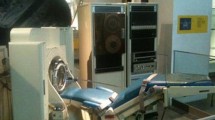Abstract
The uses of cardiac CT are multiple, including evaluation for coronary artery stenosis, quantification of coronary calcification, as well as assessment of cardiac function. With great negative predictive value, cardiac CT has good utility in ruling out coronary artery stenosis in select patients, which may obviate the need for more invasive procedures. Different imaging techniques yield variable amounts of information and radiation doses.
Access provided by Autonomous University of Puebla. Download chapter PDF
Similar content being viewed by others
Keywords
What is the major use of coronary CT angiography ? | Detecting coronary artery stenosis. |
Is coronary CT angiography a screening test? | No. |
What factors limit image quality? | Heart rate, body weight, ability to follow demands, and extent of coronary artery calcification. |
How long must patients be able to hold their breath for during image acquisition? | Approximately 10 seconds. |
What is the ideal heart rate during image acquisition? | Less than 60–65 beats per minute. |
When are beta blockers administered to help control the heart rate? | Orally, 1 hour before the scan or IV, immediately before scanning. Orally 100 mg metoprolol 1 hour prior to scan or 100–200 mg atenolol. Intravenously 5 mg metoprolol at arrival to scanner with additional 2.5–5 mg (not exceeding 30 mg). |
How much iodine-based contrast is administered during the scan? | 50–100 mL IV at approximately 4–7 mL/s. |
How is CT angiography protocolled? | Retrospective cardiac gating or prospective triggering. High-contrast flow of 5–7 cc/sec is required for optimal contrast to noise ratio. |
What are differences between retrospective vs. prospective gating? | Prospective gating is associated with less radiation exposure. Nonetheless it is extremely sensitive to heart rate changes and has limited spatial resolution to cover the entire surface of the heart in a single scan. It is only effective when HR is less 90 beats per minute and is not ideal in the setting of arrhythmias. Retrospective gating allows continuous image acquirement to then retrospectively analyze cardiac function through image reconstruction. |
What is an advantage and disadvantage of retrospective gating? | An advantage is to be able to choose an optimal cardiac phase for analysis, which does not contain motion artifact. A disadvantage is that it is associated with much higher radiation dose. |
What is the sensitivity and specificity of coronary CT? | There is high sensitivity (90–95%) and high negative predictive value to rule out stenosis. There is lower specificity and positive predictive value due to overestimation of stenosis and detection of lesions, which do not lead to ischemia. |
Which additional techniques can improve detection of ischemia? | CT myocardial perfusion scanning and computational fluid dynamics. |
Does lack of coronary calcium indicate no stenosis in symptomatic individuals? | No. There is poor correlation. |
Is coronary calcium a good measure for risk stratification of major cardiac events? | Yes. |
What is the accuracy of coronary CT in evaluating bypass grafts? | Low, often due to small diameter of the graft vessels. |
When is cardiac CT used to assess ventricular function or congenital heart disease? | When echocardiography and MRI fail. |
What is the use of cardiac CT for transcatheter aortic valve replacement ? | To measure the aortic annulus dimension. |
Further Reading
Schoepf U, et al. Coronary CT angiography. Radiology. 2007;244(1):48–63.
Sundaram B, et al. Anatomy and terminology for the interpretation and reporting of cardiac MDCT: part 1, structured report, coronary calcium screening, and coronary artery anatomy. AJR. 2009;192(3):574–83.
Sundaram B, et al. Anatomy and terminology for the interpretation and reporting of cardiac MDCT: part 2, CT angiography, cardiac function assessment, and noncoronary and extracardiac findings. AJR. 2009;192(3):584–98.
Machida H, et al. Current and novel imaging techniques in coronary CT. Radiographics. 2015;35(4):991–1010.
Chu L, et al. Cardiac CT angiography beyond the coronary arteries: what radiologists need to know and why they need to know it. Am J Roentgenol. 2014;203(6):583–95.
Desjardins B, Kazerooni EA. ECG-gated cardiac CT. Am J Roentgenol. 2004;182(4):993–1010.
Mahabadi AA, et al. Safety, efficacy, and indications of β-adrenergic receptor blockade to reduce heart rate prior to coronary CT angiography. Radiology. 2010;257(3):614–23.
Author information
Authors and Affiliations
Editor information
Editors and Affiliations
Rights and permissions
Copyright information
© 2019 Springer Nature Switzerland AG
About this chapter
Cite this chapter
Chand, R. (2019). Uses of Cardiac CT. In: Eltorai, A., Hyman, C., Healey, T. (eds) Essential Radiology Review. Springer, Cham. https://doi.org/10.1007/978-3-030-26044-6_59
Download citation
DOI: https://doi.org/10.1007/978-3-030-26044-6_59
Published:
Publisher Name: Springer, Cham
Print ISBN: 978-3-030-26043-9
Online ISBN: 978-3-030-26044-6
eBook Packages: MedicineMedicine (R0)




